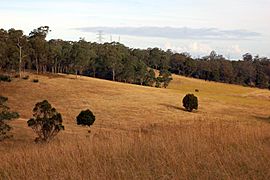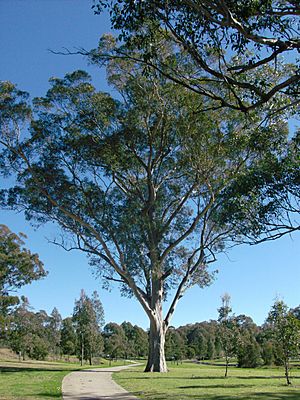Western Sydney Parklands facts for kids
Quick facts for kids Western Sydney Parklands |
|||||||||||||
|---|---|---|---|---|---|---|---|---|---|---|---|---|---|

Looking over a southern section of the parkland, from Calmsley Hill Farm in Abbotsbury
|
|||||||||||||
| Type | Urban park system and a nature reserve | ||||||||||||
| Location | Greater Western Sydney | ||||||||||||
| Nearest city | |||||||||||||
| Area | 5,280 hectares (13,047 acres) | ||||||||||||
| Elevation | 60–100 metres (197–328 ft) | ||||||||||||
| Created | 1968 | ||||||||||||
| Owned by | Government of New South Wales | ||||||||||||
| Administered by | NSW National Parks and Wildlife Service | ||||||||||||
| Visitors | 430,000-790,000 (in 2009-10) | ||||||||||||
| Open | All year | ||||||||||||
|
|||||||||||||
The Western Sydney Parklands is a huge area of parks and nature reserves in Sydney, New South Wales, Australia. It's like a giant green playground for everyone to enjoy! The NSW government has spent a lot of money, about $400 million, to create and care for this park.
This amazing park is looked after by the NSW National Parks and Wildlife Service. It follows rules set out in the National Parks and Wildlife Act 1974. The Parklands stretch from the City of Blacktown in the north, through the City of Fairfield, and all the way to the City of Liverpool in the south.
The parklands are super big, covering about 5,280 hectares (that's like 13,000 football fields!) and are about 27 kilometers long. This makes them one of the largest urban parks in the world! You can find picnic spots, sports fields, and walking tracks here. Lots of people visit every year, usually between 430,000 and 790,000 visitors. The park even helped out by providing land for the 2000 Olympic Games in Sydney.
Contents
History of Western Sydney Parklands
The land where the Parklands are now was very special to the Darug people, who are the traditional owners of this area. It is still important to the Aboriginal Land Council today. Early European settlers, like Edward Abbott and George Johnson, also visited this land a long time ago.
At first, the park area was used for farming, including growing crops, raising dairy cows, and letting animals graze. The first settlements in the Parklands area happened in Prospect in the 1790s.
Plans for the Parklands started in 1968. Western Sydney needed more open spaces and fun places for people to relax. In the late 1970s, some northern parts of the park had small country homes, but by 1997, they became part of the Western Sydney Regional Park.
In 2000, the parklands were used for some events during the Sydney Olympic Games. The final borders of the park were set in 2006. A year later, in 2007, the walking and cycling paths that wind through the park were finished and opened for everyone to enjoy.
Geography of Western Sydney Parklands
The Parklands are made up of many connected green areas. They mostly follow the western part of the M7 motorway and the M7 cycleway. The park is long and narrow, stretching from north to south.
It starts in the suburb of Dean Park in the north. Then, it mostly follows the eastern side of the M7 motorway south. Near the M4 Western Motorway, it spreads east to include the Prospect Nature Reserve around Prospect Reservoir.
The Parklands keep going south along the M7 motorway. Near Cecil Hills, it crosses the M7 to include parkland on the western side. From there, it continues south and ends in the suburb of Horningsea Park.
The park is about 27 kilometers long. It runs from Quakers Hill in the north to Leppington (Liverpool) in the south. It's right in the middle of the Greater Western Sydney area.
A noticeable ridge runs through the park from north to south. This ridge offers amazing views of Greater Western Sydney. Every entrance to the park has special plants and big signs to show you where to go in.
The Parklands are also where Eastern Creek begins. This creek flows into the Hawkesbury-Nepean River. The north-south ridge in the Parklands is where the water divides between the Hawkesbury-Nepean, Georges River, and Parramatta River areas.
Ecology: Plants and Animals
Flora: The Plants of the Parklands
The park has about 135 hectares of natural woodland areas. These are leftover parts of the original Cumberland Plain Woodland. Most of the park, about 427 hectares, has new plants that have been added, or it's open grassland. The environment in the Parklands is still very similar to how it was before Europeans arrived.
The NSW Government has been planting new trees and plants in the area through the Greening Western Sydney Program. This replanting effort has been going on since the early 1990s.
The parkland has three main types of soil. The most common is Luddenham soil, which comes from Wianamatta Shale. Some of the trees you can find in the park include Eucalyptus moluccana, Forest Red Gum (also known as Eucalyptus tereticornis), Eucalyptus crebra, Corymbia, Corymbia maculata, Stringybark, and Eucalyptus eugenioides.
Smaller plants and shrubs you might see are Blackthorn, Bursaria spinosa, Themeda triandra (also called Themeda australis), and Microlaena stipoides.
Fauna: The Animals of the Parklands
The Park is home to many special animals. Some of these are endangered species or threatened species. They are protected by laws from the State and Commonwealth governments.
You can find many native animals in the park. These include different kinds of frogs, birds, lizards, and bats. You might also see Foxes and rabbits, though they are not native.
In the northern parts of the park, from Quakers Hill to Bungarribee, there's a large group of Eastern Grey Kangaroos. There's also a good number of Fallow Deer. Overall, about eighty different native vertebrate (animals with backbones) species live in the parkland. Even birds that travel long distances (migratory birds) visit the park. A study called Wildlife Atlas found 167 different vertebrate animal species in the Park.
One group of birds that stays in the park all year round are the parrots. Many different kinds of parrots make their homes and raise their young in the park's trees. These include rainbow lorikeets, rosellas, red-rumped parrots, galahs, and cockatoos.
Some of the threatened species in the park are the Meridolum corneovirens (a type of snail), Grey-headed flying fox, little eagle, Eastern false pipistrelle (a bat), Varied sittella (a bird), East-coast free-tailed bat, Common bent-wing bat, Rüppell's broad-nosed bat, and the Turquoise parrot.
Fun Things to Do in the Parklands
| Western Sydney Regional Park | |
|---|---|

Walking path in bushland
|
|
| Type | Urban park, wildlife park, nature reserve |
| Location | Abbotsbury and Horsley Park |
| Area | 583 ha (1,440 acres) |
| Operated by | Fairfield City Council |
| Status | Open all year |
The Western Sydney Parklands has 16 main areas and 50 smaller park spots. As you travel from north to south, you'll find many parks, nature reserves, natural features, and sports facilities. Most of these areas have picnic spots and BBQ areas, pathways for cycling or walking, and children's playgrounds. The most popular places for a picnic are Lizard Log, The Dairy, and Plough and Harrow.
Northern Parklands Highlights
- Bungarribee: This area includes the Sydney Zoo, which is a great place to visit.
- Nurragingy Reserve: Located at the northern end of the park, it has a beautiful Chinese garden, a lake, and a lovely picnic spot.
- Blacktown Olympic Park: A major sports facility.
- The Rooty Hill: Another area within the parklands.
Southern Parklands Highlights
- Western Sydney Regional Park: This large area (583 hectares) has many fun places:
- Eastern Creek International Raceway: Where you can see exciting races.
- Lizard Log: A very popular picnic and play area.
- Dairy: Another favorite spot for picnics.
- Plough and Harrow: A great place for families to gather.
- Moonrise Lookout: A high spot (130 to 140 meters above sea level) with amazing views.
- Sugarloaf Ridge: Another high lookout area right next to Moonrise Lookout, with two big picnic shelters.
- Shale Hills: An area to explore.
- Calmsley Hill City Farm: An educational farm that's perfect for school children to learn about farm animals.
- Prospect Reservoir (Prospect Nature Reserve): This area has picnic spots, BBQ areas, and playgrounds for kids.
- Western Sydney International Dragway: Another place for motor sports.
- Sydney International Equestrian Centre: For horse riding events.
- Sydney International Shooting Centre: For shooting sports.
- Kemps Creek Nature Reserve: A natural area to explore.
Besides all these fun places, the Parklands also have market gardens, old military sites, and important infrastructure. This includes parts of the Upper Canal System (for water supply), pipelines, electricity lines, gas lines, and telecommunications towers. Important historical sites include The Rooty Hill and the Bungarribee Homestead archaeological site.


